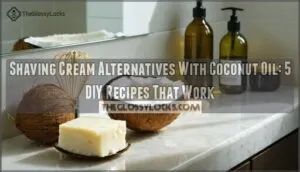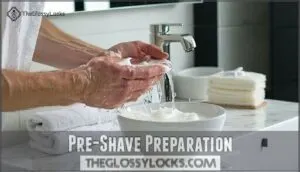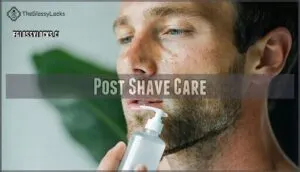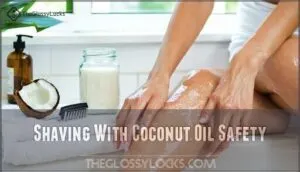This site is supported by our readers. We may earn a commission, at no cost to you, if you purchase through links.

Coconut oil glides on smoothly, softens stubble, and leaves your skin feeling like it’s wrapped in silk. It’s a natural moisturizer, so you can skip the post-shave lotion.
Some folks even mix it with olive oil or shea butter for extra slip and comfort. Just warm a bit in your hands and apply before shaving.
You’ll notice fewer nicks and less irritation. Of course, every skin type is different, so patch test first.
Curious about easy DIY recipes? There’s more than one way to pamper your skin.
Table Of Contents
Key Takeaways
- You can use coconut oil as a natural shaving cream that moisturizes, soothes, and protects your skin.
- Mixing coconut oil with olive oil or shea butter boosts slip and comfort for a smoother shave.
- Always patch test before full use to check for irritation or allergic reactions, especially on sensitive skin.
- Rinse your razor often to prevent clogging, and wash any oil-stained towels or clothes promptly.
Coconut Oil Benefits
You’ll find coconut oil works as an effective shaving cream alternative because it naturally moisturizes your skin while providing antimicrobial protection.
Coconut oil gives you a smooth, moisturizing shave while protecting your skin with natural antimicrobial benefits.
The oil’s soothing properties help prevent razor burn and irritation, making it gentler than many commercial shaving products, providing a natural and effective way to shave.
Natural Moisturizer
Why settle for harsh chemicals when coconut oil provides exceptional skin hydration? This natural emollient penetrates deeply, offering dry skin relief that commercial shaving cream alternatives can’t match.
Your sensitive skin absorbs coconut oil’s moisturizing properties without clogging pores. Unlike synthetic products, coconut oil benefits include superior oil absorption while maintaining your skin’s natural moisture barrier for ideal natural skin care.
Consistent use can improve skin texture and tone over time, which is a key aspect of using coconut oil for its moisturizing properties and achieving better skin texture.
Skin Soothing Properties
Coconut oil’s anti-inflammatory effects make it perfect for sensitive skin shaving.
You’ll notice immediate itch relief and redness reduction after each shave.
Its natural compounds promote wound healing while providing deep skin hydration.
These coconut oil benefits create a protective barrier that soothes razor burn and prevents shaving irritation relief.
It’s your skin’s gentle guardian during every shave, providing deep skin hydration.
Antimicrobial Effects
Your skin faces constant threats from bacteria and fungi, especially during shaving when tiny nicks create entry points.
Coconut oil’s natural antimicrobial properties help fight bacterial infections and fungal infections while you shave.
This natural shaving cream alternative actively prevents skin infections and supports wound healing.
When you choose coconut oil shaving over commercial products, you’re getting built-in infection prevention that keeps your skin healthier.
Shaving Cream Alternatives
You don’t need expensive shaving creams when natural alternatives like coconut oil, olive oil, and shea butter work just as well.
These simple ingredients provide the lubrication and moisture your skin needs for a smooth, comfortable shave.
Coconut Oil Shaving
When you’re ready to make the switch to coconut oil shaving, you’ll discover a game-changing natural shaving cream that works beautifully.
This DIY shaving cream alternative offers several advantages:
- Most coconut oil brands cost less than traditional shaving creams
- Hair type suitability varies, but most people see great results
- Shelf life extends months without refrigeration
- Razor clogging issues rarely occur with proper application
Coconut oil for skin provides excellent lubrication during shaving with oil.
Olive Oil Shaving
Looking beyond coconut oil, olive oil brings powerful Olive Oil Properties to your Shaving Technique.
Rich in vitamins A, D, E, and K, it delivers exceptional Skin Benefits while creating smooth Razor Glide.
This natural DIY shaving cream alternative moisturizes deeply and prevents irritation.
You can even use it to create homemade remedies, similar to Neosporin.
| Olive Oil Properties | Shaving Technique | Aftershave Options |
|---|---|---|
| Vitamins A, D, E, K | Apply to damp skin | Leave thin layer on |
| Natural antioxidants | Creates protective barrier | Soothes minor cuts |
| Moisturizing fatty acids | Prevents razor drag | Maintains skin moisture |
| Anti-bacterial compounds | Softens hair follicles | Extends blade life |
Shea Butter Shaving
Shea butter’s creamy texture creates an excellent barrier between your razor and sensitive skin.
You’ll find it glides smoothly, reducing nicks and irritation better than many commercial products.
Mix shea butter with coconut oil for the best shaving cream that doubles as a moisturizing treatment.
Store your homemade shaving cream recipe in a cool, dry place for ideal razor compatibility.
Coconut Oil Shaving Tips
If you want a smooth shave with coconut oil, you’ll need the right approach from start to finish.
Let’s look at essential tips for preparing your skin, using proper shaving techniques, and caring for your skin afterward, which includes complete concepts for a successful shave.
Pre-Shave Preparation
A good shave starts with clean, hydrated skin. Use warm water and gentle facial cleansing to remove dirt and prep for moisturizing shaving.
Try simple exfoliation methods to lift dead cells and boost skin hydration. Before reaching for your homemade shaving cream or coconut oil, smooth a thin layer on damp skin—oil application makes skinfriendly shaving a breeze.
Many users also like to use specialized shaving products for superior results.
Shaving Techniques
Once your skin’s prepped, focus on technique. Keep the blade sharp and use a 30-degree angle for skinfriendly shaving.
Glide with the grain first to reduce nicks, then reapply coconut oil for extra moisturizing shaving. Remember, multi-blade razors clog easily—single-blade works best.
Using coconut oil offers a natural alternative for a smoother shave. Think of these tips as your map for alternative shaving that’s both gentle and effective:
- Razor angles matter
- Blade sharpness counts
- Grain direction reduces irritation
Post-Shave Care
After you master your smooth shave coconut routine, post-shave care is where real comfort begins.
Hydration importance can’t be overstated—gently massage a bit of coconut oil or an aftershave balm to lock in moisture and help with redness reduction.
These coconut oil uses support irritation relief, prevent ingrown hairs, and keep your natural skincare routine strong.
That’s DIY beauty done right.
DIY Shaving Cream Recipes
You can make your own shaving cream at home using coconut oil and a few simple ingredients.
These recipes give you control over what goes on your skin and can be adjusted to fit your needs.
Coconut Oil Recipe
Ready for a smooth shave coconut experience? Grab quality coconut oil—organic works best for DIY beauty.
Melt gently, then let it cool for texture control. Store in a clean jar; cool, dark spots extend shelf life.
Ingredient sourcing matters for purity and best shaving cream results. Try recipe variations to match your needs.
Simple, safe, and one of the top shaving cream options.
Essential Oil Additions
Choosing essential oil additions lets you play with scent combinations and therapeutic benefits in your best shaving cream.
Lavender soothes, peppermint cools, and citrus energizes—each brings unique oil properties.
For specialized blends, consider exploring essential oil shaving products.
Follow usage guidelines for skin sensitivity, using a 2% dilution rate.
These ecofriendly shaving cream options rival software products in versatility, but always check copyright information for recipe sharing.
Customizing Recipes
Mixing up your own shaving cream options is all about Recipe Experimentation.
Try Ingredient Substitutions like swapping coconut oil for shea butter, or play with Texture Modifications for a smoother glide.
Flavor Enhancements—think essential oils—add a fresh twist.
For ecofriendly shaving, focus on simple blends.
Need Dietary Adaptations? Use hypoallergenic oils.
For sensitive skin, consider adding aloe vera.
Explore software tutorials, demos, and reviews for more ideas.
Shaving With Coconut Oil Safety
When you use coconut oil for shaving, it’s important to understand how to prevent irritation, allergic reactions, and razor burn.
Knowing the right techniques and watching for skin changes can help you shave safely and effectively.
Skin Irritation Prevention
Often, sensitive skin reacts to shaving, but you can sidestep irritation by exfoliating before each shave and keeping your razor sharp—razor dullness is a recipe for trouble.
Hydration methods, like applying coconut oil, help soften hair and skin.
Swap harsh aftershave for gentle alternatives, boosting software usability and quality—think of your skin’s reliability and performance, not just your software’s security.
To further soothe the skin, consider witch hazel applications to reduce irritation naturally with gentle alternatives.
Allergic Reactions
When using coconut oil for shaving, it’s smart to identify allergens before you get started.
Patch testing helps you spot reaction severity early, so you can avoid trouble.
If you notice redness or itching, switch to alternative oils.
For stubborn symptoms, seek medical intervention—think of it like software troubleshooting for your skin, ensuring smooth “software installation” and updates.
- Identify allergens first
- Try patch testing before full use
- Monitor reaction severity closely
- Consider alternative oils if needed
Razor Burn Prevention
If allergic reactions are off your radar, let’s talk razor burn prevention.
Exfoliation Importance can’t be overstated—think of it as prepping your skin for a smooth software installation.
Hydration Methods soften hair, a Sharp Razor reduces tugging, and following the right Shaving Direction helps.
For Aftershave Options, stick to gentle products, just like software updates and patches for trouble-free support.
| Prep | Shave | Aftercare |
|---|---|---|
| Exfoliate | Sharp Razor | Soothe Skin |
| Hydrate | Shaving Direction | Aftershave |
| Clean Tools | Slow Strokes | Moisturize |
| Support | Troubleshooting | Software Patches |
Frequently Asked Questions (FAQs)
Does coconut oil clog razors during shaving?
Coconut oil can clog your razor if you use too much, since it’s thick and sticky.
To avoid buildup, rinse your razor often under hot water.
You’ll get a smoother shave and keep your blade sharp.
Can coconut oil stain towels or clothing?
Like a drop of oil on a white shirt, you might notice stains if coconut oil gets on towels or clothing.
It can leave oily marks, so wash items promptly with hot water and detergent for best results.
Is coconut oil suitable for sensitive areas shaving?
You’ll find coconut oil gentle enough for sensitive areas, thanks to its natural moisturizing properties.
It glides smoothly, reduces friction, and helps prevent razor burn.
Just do a patch test first—everyone’s skin tells a different story.
How does coconut oil affect razor blade lifespan?
Back in the day, folks might’ve used a straight razor and soap, but with coconut oil, you’ll notice blades last longer.
Its slick texture reduces friction and clogging, helping you get more shaves before swapping blades.
Does coconut oil have a strong scent after shaving?
You won’t notice a strong scent lingering after shaving.
The natural aroma is mild and fades quickly, so it won’t clash with your favorite cologne or lotion.
Most people describe it as barely there, clean, and subtle.
Conclusion
Like a smooth river stone, shaving cream alternatives with coconut oil help your razor glide while keeping your skin calm and hydrated.
You’ve got options—pure coconut oil, or blends with olive oil and shea butter.
Each recipe is simple, effective, and easy to tweak for your needs.
Always patch test first, and pay attention to your skin’s response.
With these tips, you can ditch store-bought creams and enjoy a smoother shave every time.
- https://survivalfreedom.com/5-substitutes-for-shaving-cream-ranked-best-to-worst/
- https://shavingadvisor.com/creams/shaving-cream-alternatives/
- https://www.byrdie.com/shaving-cream-substitute-5087485
- https://www.allinthedifference.com/alternative-to-shaving-cream/
- https://headcurve.com/beauty/shaving-cream-alternatives/











